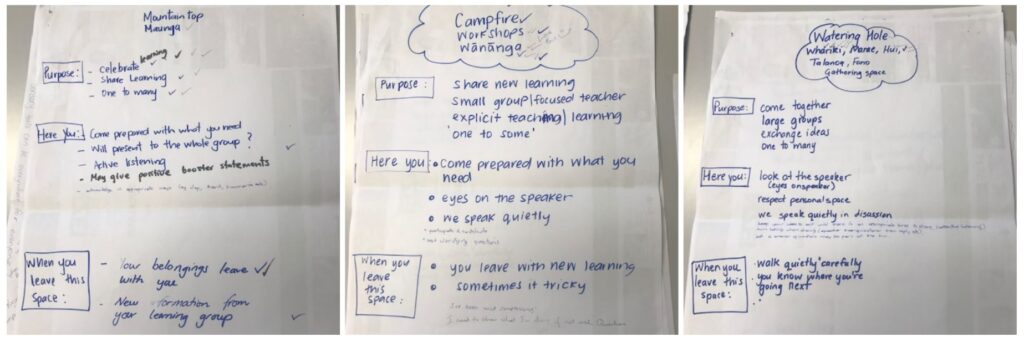Week 11
In our last post from Grey Lynn School (NZ), the staff wanted to develop how they could clearly identify and convey what a learning activity involved and how it was going to be conducted in the specific zone within the learning space.
Our New Zealand facilitator, Doug Crutch met up with School Principal, Alicia Whata and her leadership team to show them a photo he had taken in a corporate collaborative area, that simply indicated what was expected in that space.
Alicia and her team felt it was visual, simple and clear. Alicia explained, “Because we didn’t have a description or in fact a shared understanding of what the learning zone might be used for, our next step was to come up with a common language to define these activities and zones, and then clearly and simply display that information to the staff and children.”
During a workshop being facilitated by Sandra Jenkins, initial discussions with the learning teams highlighted that there was inconsistency in their understanding of the activities and zones, but it was agreed by all, that they wanted the same language around what learning zones look like and their purpose. This could be done through using the same terminology across the whole school, from their newest learners right up to their our older ones. During this session, the teachers went on to contribute the names of the activities, their understandings and ideas on how they thought the information would be used and this was then drafted into a shared understanding which resulted in five activity posters.

As well as the names and descriptions on the posters, Alicia identified the need for pictures of the children in the learning hubs doing the activities, to be included on the activity posters because as she said, “You could put in all sorts of images but if the children see themselves in that activity, it will be more meaningful and it’s very important to personalise the process”.
Doug also spoke to Lucy who is a teacher (to students in years 1 and 2) to find out how the journey has been so far from a staff perspective.
Lucy said, “The workshop inspired some valuable discussion about what the zones and activities really meant to different the teams who had different ages and learners.”
“There was a lot of discussion on the naming of the activates and zones and a big part was that ‘Te Reo’ (the Māori language) was to be used to name them. The name is the first thing you see on the poster and it is the gateway to understand what that zone or activity means. Using Te Reo will empower our learners to use these terms every day in their learning and share what they mean with their families.”
This term will be the first time that the year one and two students have used all of these names. Lucy is looking forward to unpacking the posters with the children and teaching them about their meaning and how to use them. She also feels that because the posters are visual and a ‘Talking Point’, they will help clearly explain the activities for families and visitors who come into the space.

The school plans to carry out a review after 4 weeks of use, to measure the impact of the posters and to consider what might need to be adapted.
Once the review is under way, the school also wants to investigate how practical it will be to take the posters off the walls and place them into the middle of the zones, to help define and support the activity.

Bhavini Pandya
Gratnells Learning Rooms Leader and Lead Project Facilitator

